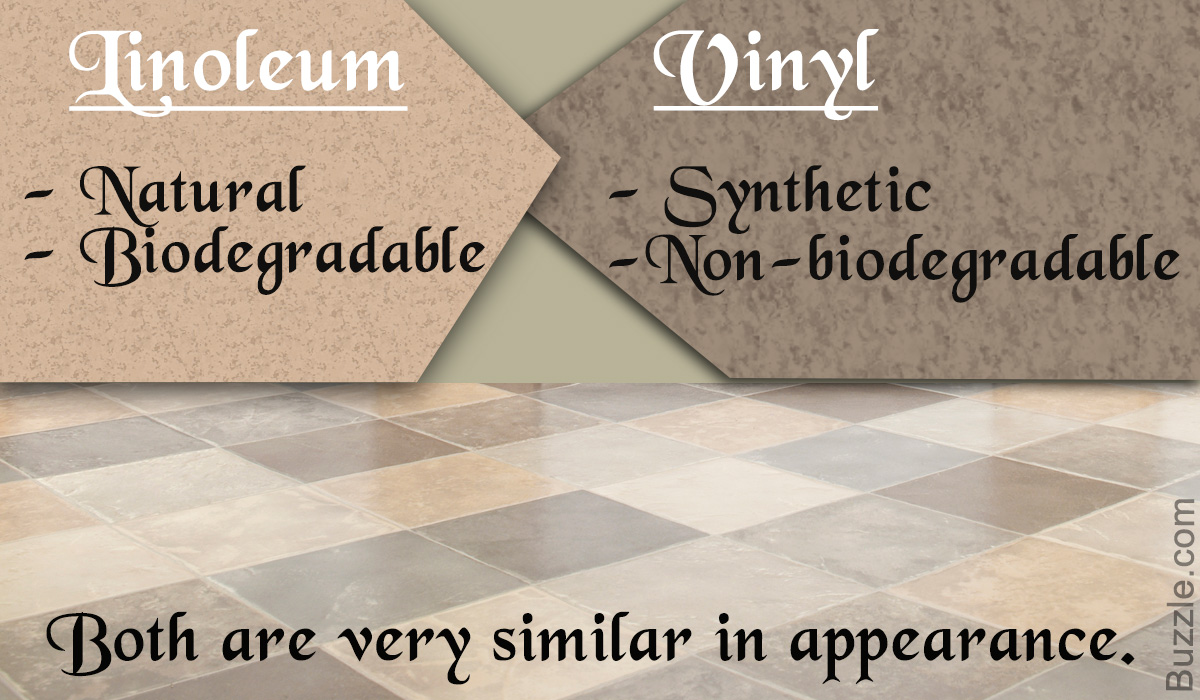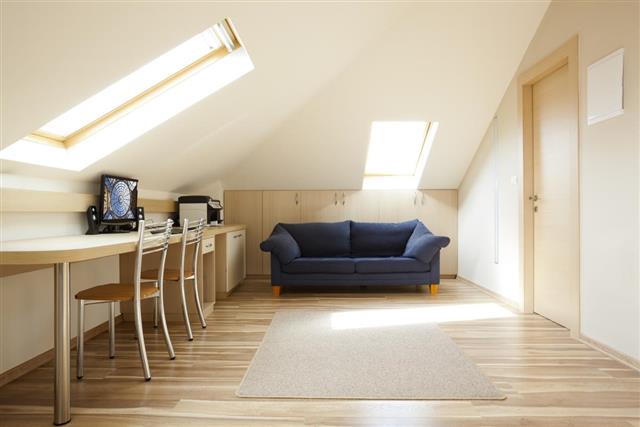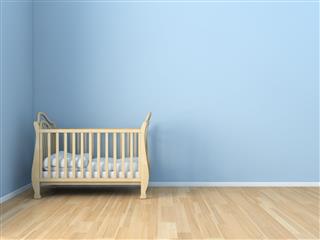
Both linoleum and vinyl are often referred to as ‘grandma’s drab kitchen floor’, and they have similar qualities too. So, what sets them apart? Find out here.
Often used interchangeably even by seasoned flooring dealers, linoleum and vinyl are very different materials, though they may appear very similar.
Though once called outdated, both linoleum (colloquially called ‘lino’) and vinyl flooring are back with a bang, and for more reasons than one. Both fall under the category of resilient flooring, a type that is slightly soft (bouncy) and can restore its original form even after pressure from heavy objects such as furniture. Despite several similar characteristics, lino and vinyl are quite different. And here, we analyze the difference so that you can make the right choice when deciding what to purchase. Remember, both look amazing, both are affordable, and both make a grand statement at a price that no one needs to know.
Composition
Linoleum is largely a natural material. Comprising linseed oil, cork dust, wood flour, limestone, mineral pigments, and pine rosin on a jute backing. Linoleum is popular for its environment-friendly nature.
Vinyl, on the other hand, is a synthetic material where the primary ingredient is polyvinyl carbonate or PVC, which is obtained from petroleum. Other products that contribute to its composition include fiberglass, dyes, and felt. It is constructed in layers with a urethane coat forming the top layer, followed by vinyl, then by the design/pattern, and then by felt or fiberglass for the base. Vinyl is now available with a fiberglass core for added strength and cushioning.
Both provide a soft underfoot, and are great for people who spend a long time standing on hard surfaces.
Winner: Linoleum for its all-natural components
Appearance
The color and pattern on linoleum is present throughout the piece. As such, even as it wears out, it reveals layers of colors and patterns to look brighter and fresher. However, this limits the number of designs and colors it is available in. During the manufacturing process, linoleum develops what is known as a bloom or a yellow film as the linseed oil is oxidized. This often disappears when the flooring is exposed to natural light over a few days or weeks.
Vinyl is available in an endless variety of colors and patterns, which makes it popular among homeowners. It has a certain amount of translucency that makes it bright and vibrant. However, the pattern is often only surface-printed and does not extend through the entire tile/sheet. Vinyl products that have inlaid patterns are now available, though they are definitely more expensive.
Winner: Linoleum for its inlaid patterns and colors
Durability
Linoleum is found to be more durable than vinyl, having been known to last for 30-40 years. It is also antistatic and repels dust, and is a great choice for a house with pets and kids. Another great property of linoleum is that it is naturally anti-bacterial. It is also hypo-allergenic. Linoleum can handle areas with high traffic with ease. Over time, the linseed oil cures and hardens, making it more durable in the long run.
Though high-quality vinyl flooring is being manufactured, it cannot last as long as linoleum. It will probably last for a good 15-20 years though. Vinyl is prone to scratches, and while it can absorb the impact of heavy weight objects dropped on it, it can tear if sharp objects fall on it. In comparison, linoleum can hide these minor nicks and scratches because the color and design is embedded through and through. Vinyl has patterns printed on the surface that can wear away easily over time.
High-quality vinyl floors have a top layer that consists of compounds that strengthen its top coat so that it lasts much longer.
Winner: Linoleum for its ability to withstand the vagaries of nature and human activities for decades
Price
Linoleum is more expensive than vinyl. However, with better varieties of vinyl being produced now, the prices are almost the same. Your choice then boils down to the other factors mentioned here. Linoleum may start at USD 5 per square foot, but vinyl starts at USD 1 per square foot. Low-priced products are likely to be of poor quality and not very durable, so be careful.
Winner: Tie
Maintenance
The maintenance of both flooring types depends mainly on how they are laid.
Linoleum is water-resistant, not waterproof. It is important to note that while it is recommended for areas such as kitchens and baths, it should be installed professionally to prevent water from penetrating to the subfloor and warping the material. Sheet linoleum is best for bathrooms since it reduces the number of seams that can become potential spots for water to seep in. These should be welded and then sealed with 3-4 coats of acrylic sealer. It is best to hire a professional for the job rather than attempting it yourself so that the floor lasts as long as it is claimed. With linoleum floors, any spillage should be wiped off immediately, because too much exposure to water will cause the sheet to curl up and rot. It should be cleaned only with non-abrasive cleaners and without detergent of any kind. Regular vacuuming or sweeping along with weekly mopping with cool water and a recommended cleaner should have your floor last for years to come. It does not tolerate cleaning products with a high pH. Manufacturers recommend products that should be used for cleaning linoleum, and also tell you how often you should be waxing the floors. Experts suggest that waxing is necessary when regular cleaning fails to retain the shine of the floor.
Vinyl is a more forgiving material than linoleum, in that, it can tolerate all sorts of spillage. It can also be cleaned with any regular floor-cleaning product, and it will not lose its shine as quickly as linoleum will. Though fire-proof varieties are available, vinyl is not recommended in areas where fire may pose a hazard. Vinyl floors will require the application of a sealant every few years. They are water-resistant too, but again, any cuts or nicks in the floor will expose it to water, thereby resulting in damage of the pattern in the tile/sheet. Heavy furniture should not be dragged over vinyl flooring and should be padded when placed on such floors to prevent dents from constant weight.
Winner: Vinyl for its low maintenance
Installation
Both vinyl and linoleum are available in sheets as well as tiles. Vinyl is also available as planks. While vinyl flooring installation is the DIYer’s forte (all it needs is basic pre-installation work), experts suggest that linoleum be installed by a professional. In both cases, sheet installation is tricky and requires a clean, level, moisture-free subfloor. However, vinyl can be installed over existing tiles or vinyl flooring. Also, finding professional linoleum flooring installers may pose a problem.
Winner: Vinyl for its easy-to-install properties
Environmental/Health Impact
Linoleum is biodegradable as well as recyclable. It is made of natural products and, therefore, is considered a green flooring option. However, its manufacturing process has been questioned with regard to its environmental friendliness. It can be said though, that its impact on health is nil, unless someone is specifically allergic to linseed oil. Its antimicrobial and hypoallergenic properties make it a great choice for any home.
Vinyl is made from a byproduct of petroleum, which makes this the first reason why it is not environment-friendly. On the other hand, great measures are being taken to recycle vinyl so that it may be reused and fossil fuels are not depleted in its manufacture. It is also known to contain volatile organic compounds (VOC) that can emit toxic gases and affect indoor air quality. Now, popular flooring brands such as Armstrong provide low-VOC and recyclable vinyl flooring, that make it safe for home use. If vinyl flooring does catch fire, it will release toxic gases into the air and can pose a hazard for residents. As such, its use is not recommended in areas where fire hazards may be common, such as commercial kitchens.
Winner: Linoleum for being biodegradable
Linoleum is best used in living rooms, kitchens, bathrooms, and hallways. Vinyl is best used in basements, kitchens, bathrooms, and laundry rooms. The reason why vinyl is so popular is because it’s relatively low maintenance. However, its environmental impact, though now greatly reduced, is still something to be concerned about. As such, if you do decide to invest in it, look for a good manufacturer’s warranty, and purchase a product that will last you long. Linoleum, otherwise, is a great choice for homes, and if installed properly and maintained well, will provide every penny’s worth for a long time to come.











